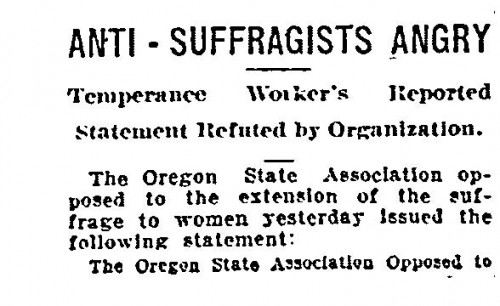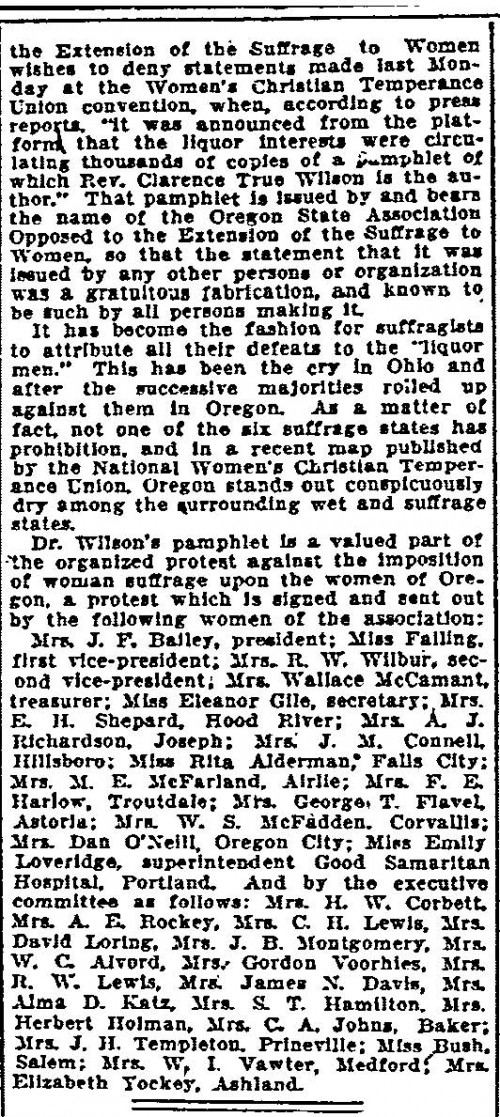October 1912: Eva Bailey and the Oregon State Assn. Opposed to the Extension of Suffrage to Women
I’m very pleased to introduce Diane Voltin who is serving as guest author for this month’s installment of This Month in Oregon Woman Suffrage History. Ms. Voltin was a student in Janice Dilg’s Winter 2012 capstone course at Portland State University titled Monumental Women. In the course students developed a walking tour of Portland that highlighted people and places important to the 1912 suffrage campaign. Ms. Voltin is a 2012 graduate of Portland State University with a degree in Social Science and with interests in history and geography.
In the following selection, Voltin invites us to consider the ideas and tactics of Eva Bailey and other Oregon women who opposed woman suffrage. She raises important questions about the nature of women’s relationship to the state and to citizenship as she investigates Bailey and other anti-suffragists in the 1912 Oregon campaign. She also gives us a glimpse of the sparring between supporters and opponents with a wonderful rebuttal of Bailey and the anti-suffrage position from Abigail Scott Duniway.
—Kimberly Jensen
The issue of temperance played less of a role in the suffrage fight in the 1912 election than it had in previous elections, but the “liquor interests” still loomed large concerning the issue. This letter to the editor of the Oregonian, signed by the elected title-holders and members of the Oregon State Association Opposed to the Extension of Suffrage to Women, refuted the claim made at the Women’s Christian Temperance Union convention that men who sold liquor had anything to do with the writing or distribution of an anti-suffrage pamphlet. While some women in Oregon were unwilling to have the vote “imposed” on them, women such as Eva Bailey, president of the Oregon State Association Opposed to the Extension of Suffrage to Women, demonstrated the ability of women to influence the political process in Oregon.


“Anti-Suffragists Angry: Temperance Workers Reported Statement Refuted by Organization,” Oregonian, October 24, 1912, 4.
The Oregon State Association Opposed to the Extension of Suffrage to Women was the organized and public face of the anti-suffrage movement. Their argument against granting suffrage to women in Oregon, as detailed in the 1912 Oregon Voter’s Pamphlet, was based on the belief that woman, “has done her part in the home and not on the hustings, and her power for good is the greater because she has been content to be a woman and has not striven to be an imitation man.” (Oregon Secretary of State, Voters Pamphlet for the General Election, 1912 [Salem: Oregon State Printer, 1912], 7.) Anti-suffragists cautioned that granting the vote to women might give women the appearance of being more like men on a surface level, but stressed that doing so should not be confused with actually making women equal to men, which anti-suffragists considered a fundamental impossibility. The anti-suffrage movement also argued that the ability to vote was a duty, not a privilege, and that the household, not the individual, was the unit of the state, negating the need for married couples to vote individually, as the man’s vote represented his entire household.
As president of the public face of the anti-suffrage movement in Oregon, Eva Bailey presented a paradox: how could an active, highly organized (and successful, until 1912) association claim that women should not enter the public sphere, especially in the ugly world of politics, while their group attempted to influence the political process? Eva Bailey’s answer to that was to utilize a passive approach that relied on strategies such as letters to the editor of the Oregonian, paid advertisements, and a refusal to engage in public debate even when challenged. Bailey claimed that to engage in public debate would create noise that “means nothing and accomplishes nothing. The people who do not want women to vote are not the kind that get out and shout, and they will take care of us at the next election, the same as they have done in the past.” In addition, Bailey cautioned that history showed that any group granted the vote never had the vote taken away, and that Oregonians should let California and Washington, who had already approved women’s suffrage, “experiment for us.” (“Let California and Washington Experiment for Us,” Oregonian, November 4, 1912, 11.)
While Eva Bailey made use of the news media in her role as president of the Oregon State Association Opposed to the Extension of Suffrage to Women, little is known about her personal reasons for opposing woman suffrage in Oregon. She was born Eva Agnes Wilson in Illinois in 1869, and married Dr. Francis J. Bailey in Washington in 1900. Francis and Eva Bailey purchased a large residence in Tacoma but lived in Portland during the 1912 election, and Eva maintained an active membership in the Multnomah Chapter of the Daughters of the American Revolution. (“Portland Man Buys Home,” Oregonian, October 18, 1912, 1; “Society,” Oregonian, March 1, 1908, 2). Eva Bailey was referred to as, and only referred to herself by, her married name of Mrs. F.J. Bailey, and after the suffrage victory in 1912, Abigail Scott Duniway, as she had throughout the campaign, mentioned her anti-suffrage counterpart in an interview with the Oregonian. Hinting at the traditional gender roles that Eva Bailey attempted to protect by opposing women’s suffrage, Duniway joked that, “Now that we have won, I wish Mrs. F.J. Bailey, the president of my esteemed opponents, would remain in Portland, instead of going to Tacoma, for she can now vote here just as easily as she can there. What is more, I am sure she will find us just as motherly, just as fond of our homes, in fact, just as much womanly women as we were, and no more allied to the particular societies than we ever have been.” (“Suffrage Result is Interesting,” Oregonian, November 10, 1912, 13.)
—Diane Voltin
Want to read more articles from Oregon suffrage campaigns? Click here
Permalink

